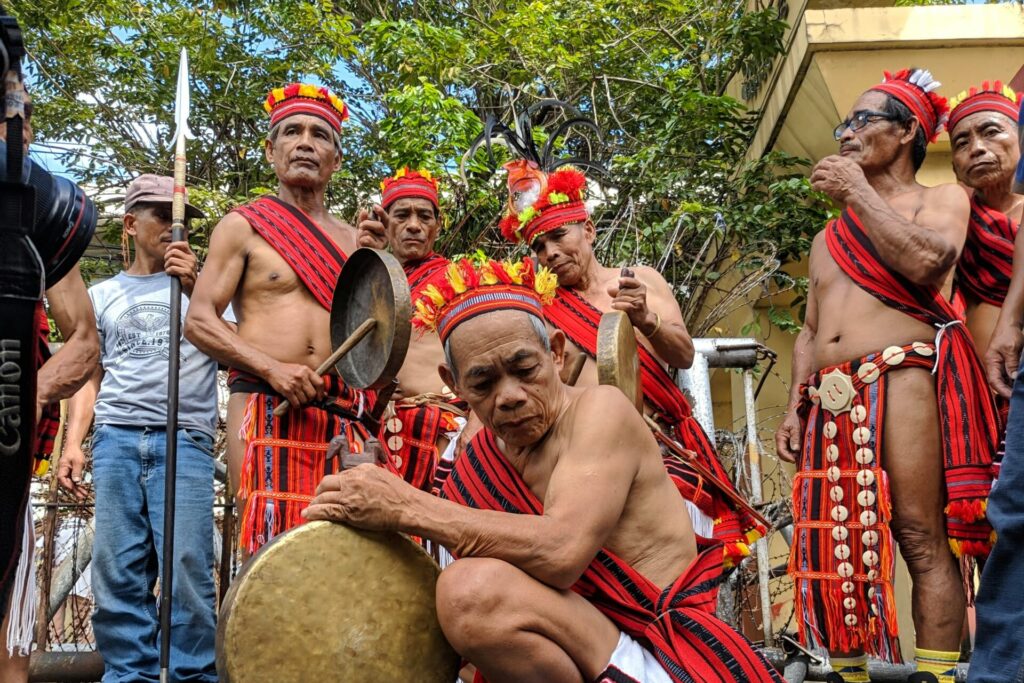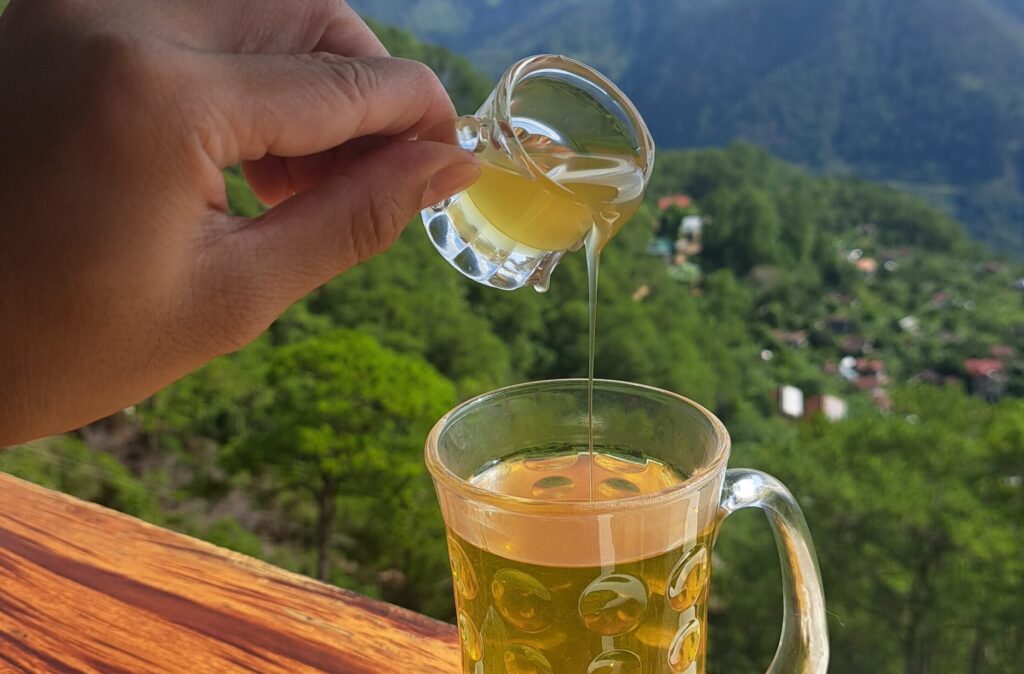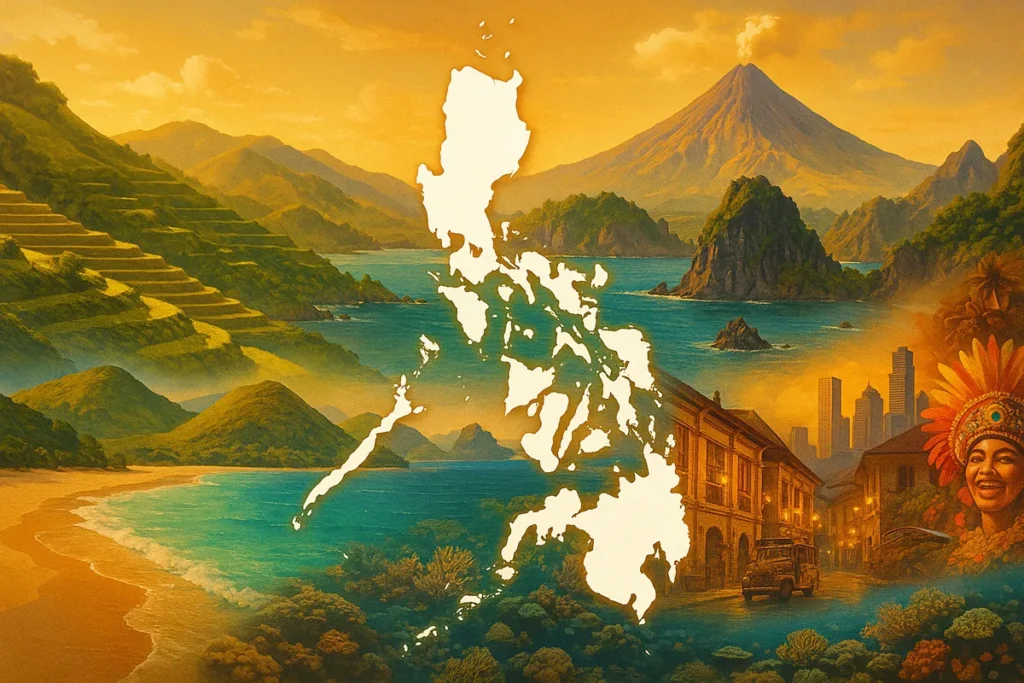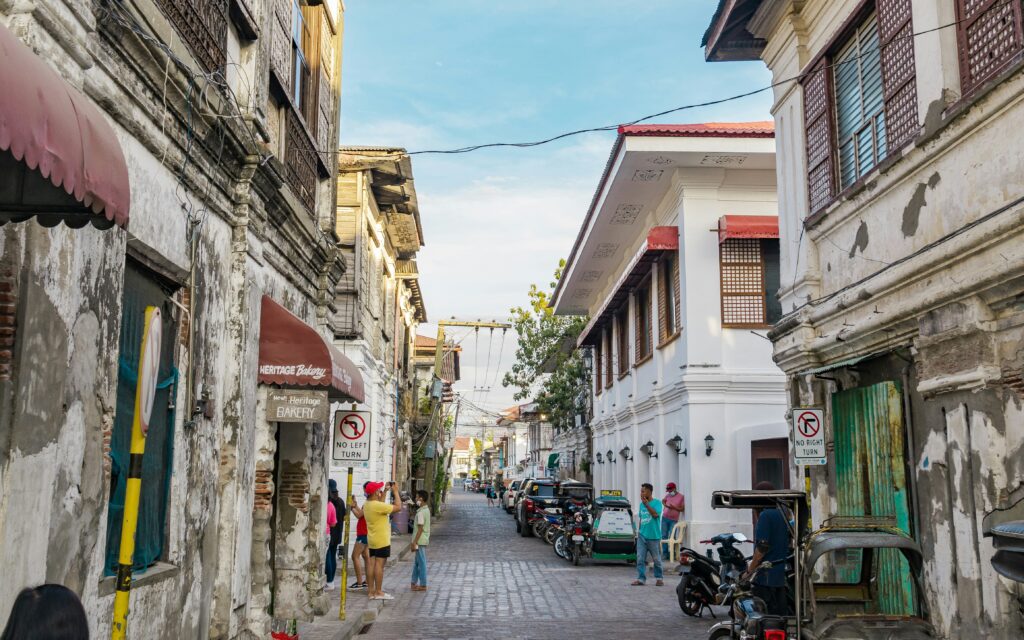The Cordillera, officially known as the Cordillera Administrative Region or CAR, is tucked high in the northern mountains of Luzon. It is a place where pine trees grow tall, the air turns cool, and the landscapes seem to stretch forever. This region in the Philippines has no coastline, yet it never feels lacking.
CAR is made up of 6 provinces: Abra, Apayao, Benguet, Ifugao, Kalinga, and Mountain Province.
Benguet welcomes you with Baguio City, the country’s well-loved summer capital. Ifugao tells stories through its world-famous rice terraces. In Kalinga, the powerful Chico River draws adventurers while centuries-old tattooing keeps history alive on skin.
Mountain Province has Sagada, a town that has become a rite of passage for many with its caves, cliffs, and sunrise viewpoints. Abra and Apayao, less traveled but full of charm, hide waterfalls, caves, and quiet villages waiting to be explored.
This Cordillera tourism guide covers each province, the food you should try, the cultural experiences worth joining, and the natural wonders you cannot miss.
Cordillera Tourism Guide | 6 Provinces & Best Highlights
📍 Location
The Cordillera lies in the northern highlands of Luzon. It is the only landlocked region in the Philippines, surrounded by rugged mountains, pine forests, and ancient rice terraces.
🌤️ Climate
Cooler than most of the country. Expect chilly nights in Benguet and Mountain Province. Best time to visit is November–May, while the rainy season makes the terraces lush but roads tricky.
🗣️ People & Languages
Home to diverse groups like the Ifugao, Kalinga, Bontoc, Tingguian, and Kankanaey. Ilocano, Filipino, and English are also widely spoken. Known for weaving, tattooing, and strong community traditions.
🚌 Accessibility
Main gateway is Baguio City, a 4–6 hour bus ride from Manila. Northern provinces are more accessible from Tuguegarao. Loakan Airport in Baguio recently reopened for select flights.
🌾 Special Identity
Famous for rice terraces carved into mountainsides, misty valleys, waterfalls, caves, and vibrant markets. Life here remains rooted in tradition, balancing heritage with modern living.
🎉 Festivals & Events
Panagbenga in Baguio, Lang-ay Festival in Mountain Province, and Imbayah in Ifugao showcase Cordillera’s vibrant culture and enduring traditions.
Cordillera Tourism Guide: The 6 Provinces
Cordillera Tourism Guide: Province #1. Abra
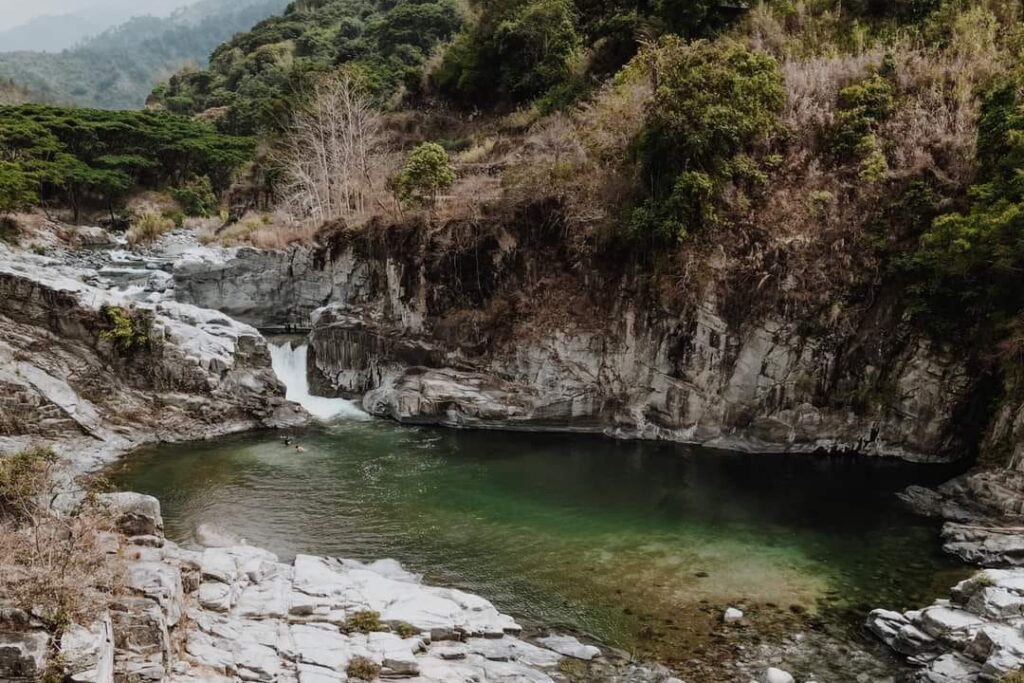
Abra lies on the western side of the Cordillera, a province surrounded by rugged mountains and wide valleys that remain largely untouched by mass tourism. Known as the land of the Tingguian people, Abra is rich in cultural heritage expressed through its weaving traditions, age-old rituals, and vibrant festivals. In the capital, Bangued, travelers can explore historic churches, ancestral homes, and lively markets where locals sell handwoven fabrics and root crops.
Nature lovers will also find plenty to discover, from the cascading Kaparkan Falls, which looks like natural limestone terraces, to caves tucked into the mountainsides. For many visitors, the charm of Abra is its quiet authenticity—it offers a glimpse of Cordilleran life away from the crowds. A trip here is about slowing down, meeting locals, and uncovering hidden corners that rarely make it into guidebooks.
Cordillera Tourism Guide: Province #2. Apayao
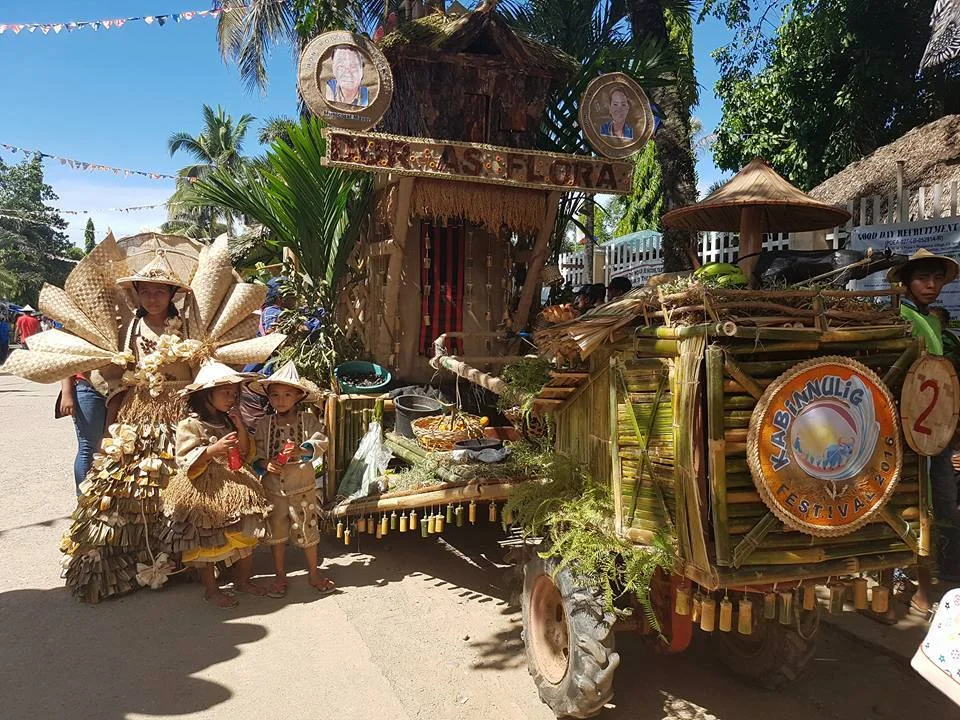
Apayao sits at the northern edge of CAR, a province with vast forests, wide rivers, and a quiet charm that rewards those willing to travel the extra distance. Known as the “last frontier of the north,” it is home to the Isnag people, whose traditions are deeply tied to the land and rivers. The province’s landscapes are dramatic, with towering waterfalls such as the majestic Lussok Crystal Cave and the boulder-strewn Apayao River, perfect for eco-adventures and kayaking.
Apayao is also a haven for biodiversity, serving as one of the country’s richest areas for wildlife and bird species. While tourism here is still developing, the raw and unspoiled quality of its natural attractions makes it an appealing destination for those who prefer less-traveled roads. For travelers seeking authenticity, Apayao offers experiences that feel both grounding and adventurous.
Cordillera Tourism Guide: Province #3. Benguet
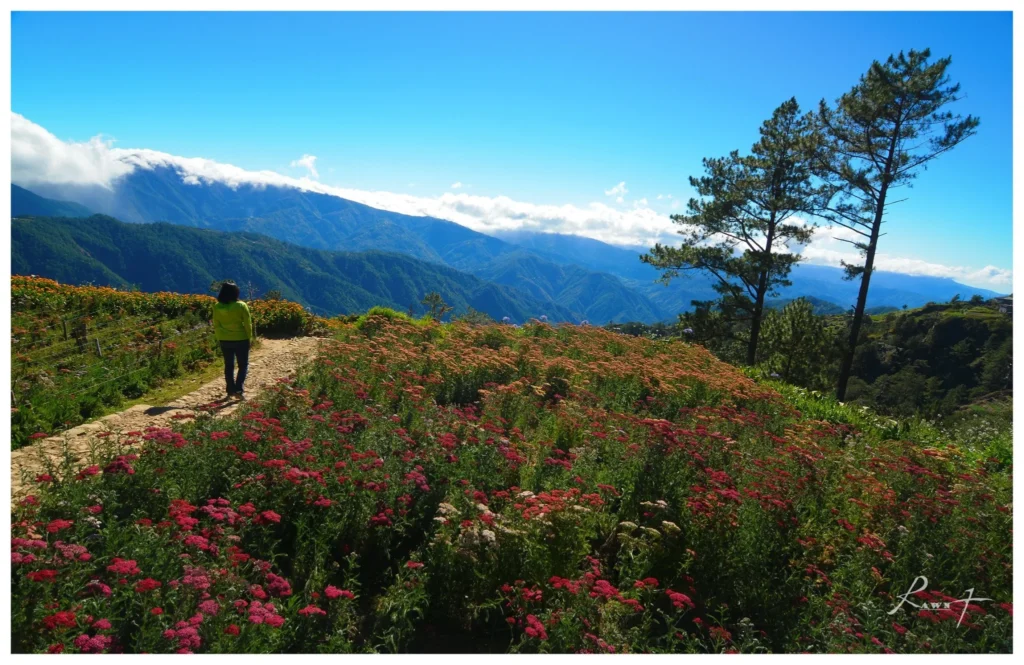
Benguet is often called the “Salad Bowl of the Philippines,” a title earned through its fertile farmlands that supply much of Luzon with fresh vegetables and strawberries. It also holds Baguio City, the Summer Capital of the Philippines, where cool mornings, flower festivals, and bustling markets have made it one of the country’s most popular highland destinations. Beyond the city, Benguet’s treasures unfold in places like Mount Pulag, famous for its breathtaking sea of clouds and stargazing opportunities, and the strawberry farms of La Trinidad.
Adventure seekers can also explore hiking trails that weave through pine forests and terraces carved into mountain slopes. The province blends tradition and modernity, where indigenous Ibaloi and Kankanaey customs are still practiced alongside contemporary mountain living. Whether you’re sipping Benguet-grown coffee in a quiet café or trekking to remote viewpoints, this province offers both comfort and exploration in equal measure.
Cordillera Tourism Guide: Province #4. Ifugao
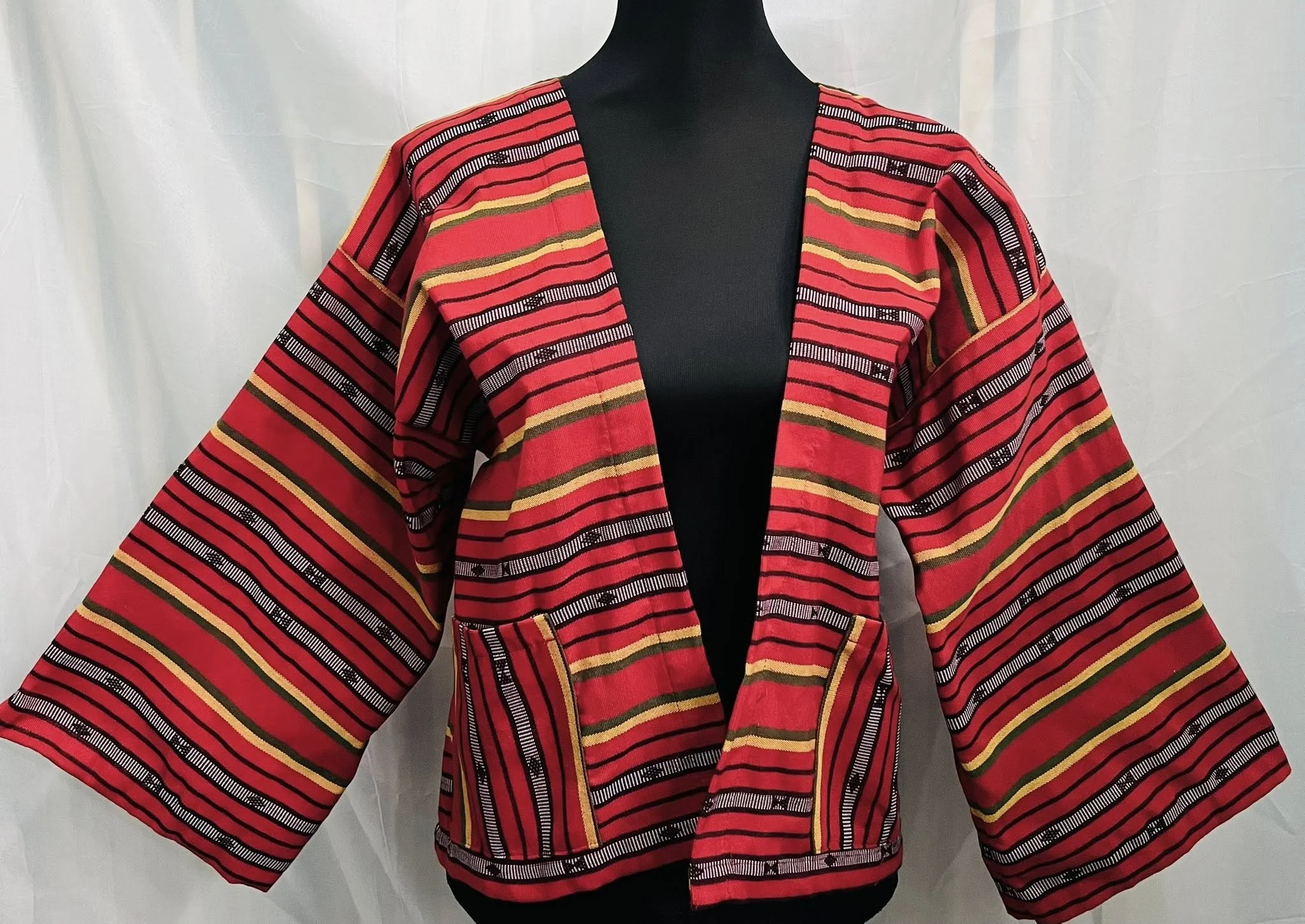
Ifugao is the cultural treasure chest of CAR, world-renowned for the Banaue and Batad Rice Terraces. These stair-like fields, carved into the mountains over 2,000 years ago, stand as a UNESCO World Heritage Site and a symbol of the Ifugao people’s ingenuity. Travelers who trek through these terraces often stay in traditional wooden houses, immersing themselves in local life while learning about farming cycles that are still celebrated with rituals and feasts.
Beyond the terraces, Ifugao has hidden gems like Tappiya Falls in Batad and the weaving villages where women still create textiles patterned after ancestral designs. The province also keeps alive the tradition of rice wine making, which plays an important role in ceremonies and communal gatherings. Visiting Ifugao is not just about sightseeing—it’s about stepping into a living culture where the land and its people remain deeply connected.
Cordillera Tourism Guide: Province #5. Kalinga
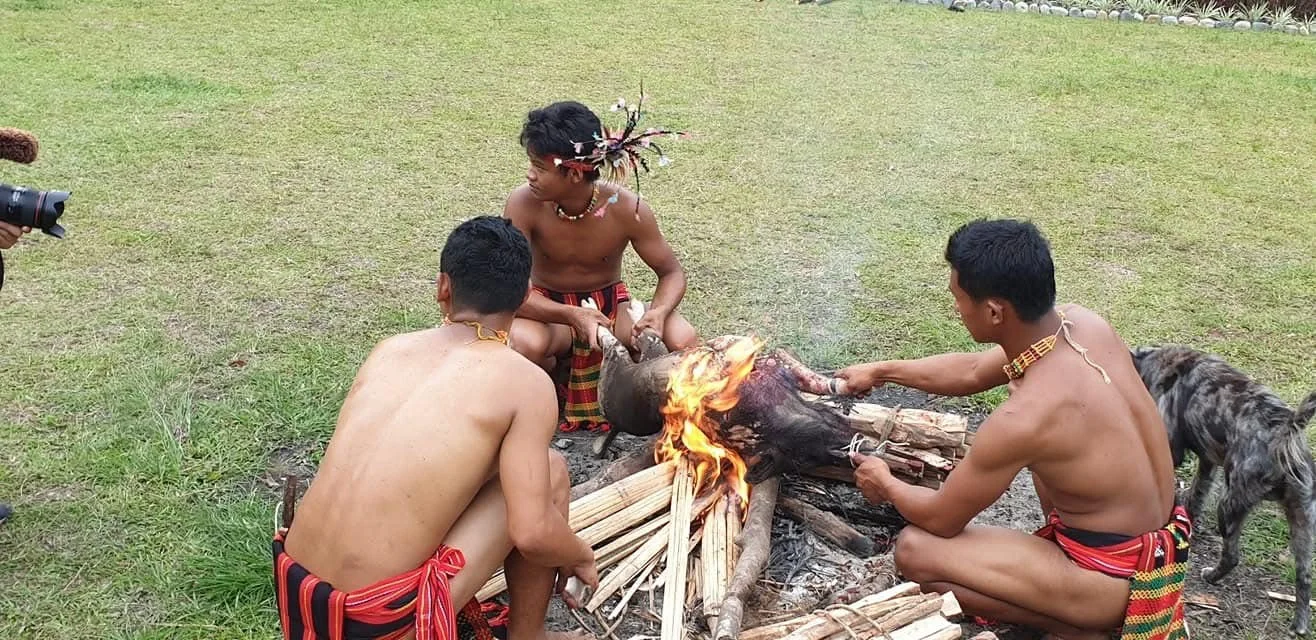
Kalinga is a province that exudes both adventure and heritage. Its landscape is marked by rivers, rice fields, and rugged mountains, with the Chico River standing out as a hub for whitewater rafting and river adventures. The province is also famous for its tattooing tradition, once a marker of bravery and identity, now sought by travelers from all over the world. The late Whang-od, a legendary tattoo artist, helped introduce Kalinga’s artistry to a global audience, and many villages still carry on this craft today.
But there’s more to Kalinga than tattoos—the province is dotted with cultural villages, waterfalls, and heritage sites that reflect its rich past. Festivals, bodong (peace pacts), and storytelling are part of everyday life, giving visitors a chance to experience the resilience and warmth of the Kalinga people. For those seeking both cultural immersion and outdoor adventure, Kalinga is a destination that leaves a lasting impression.
Cordillera Tourism Guide: Province #6. Mountain Province
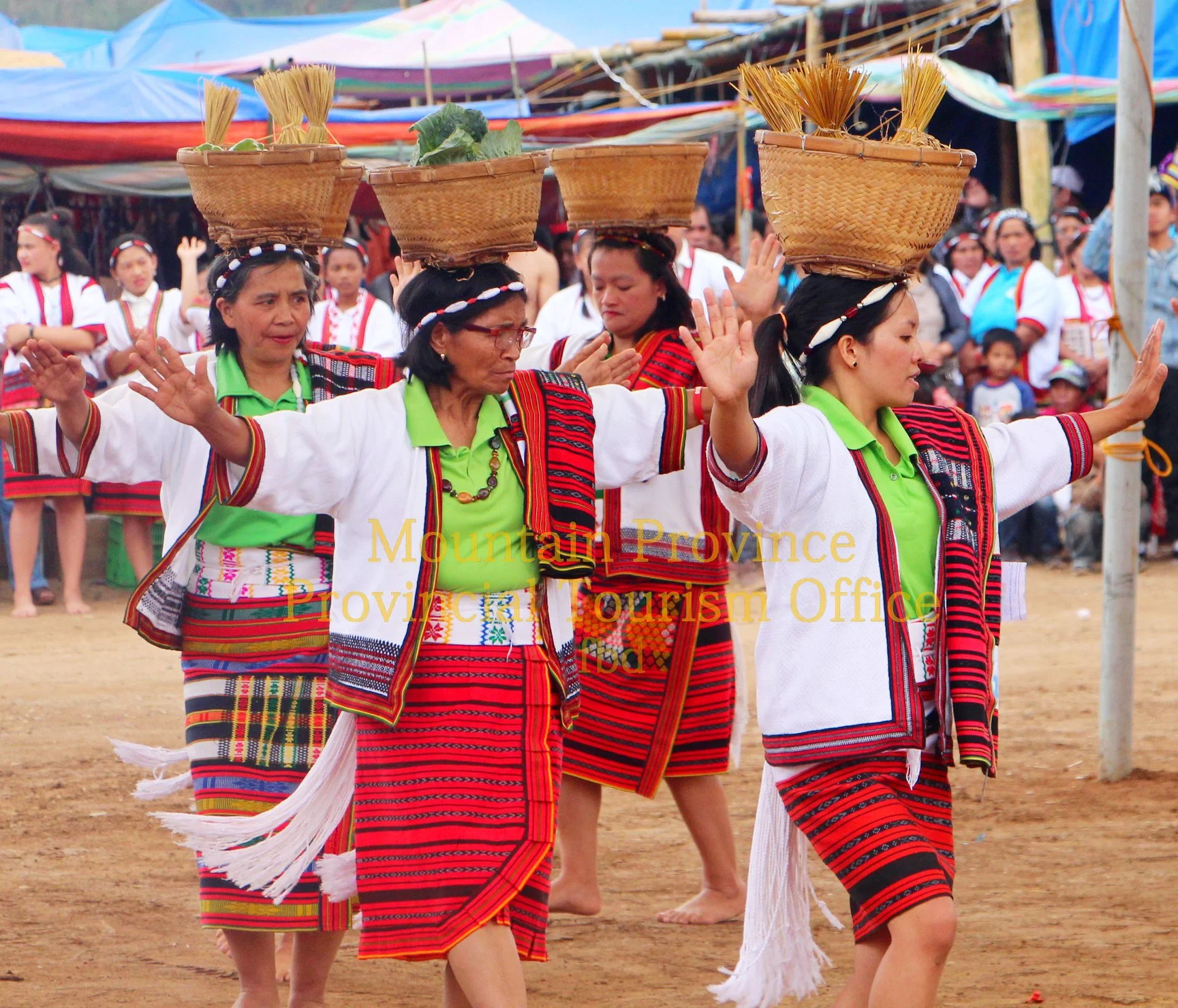
Mountain Province is the cultural and geographical heart of the Cordillera, offering a mix of natural wonders and rich traditions. Its most famous town, Sagada, has become a rite of passage for many Filipino travelers, thanks to its hanging coffins, echo valley, and limestone caves perfect for spelunking. Sunrise at Kiltepan or Marlboro Hills reveals breathtaking mountain views, while the town’s quiet streets and cafés give it a laid-back charm.
The capital, Bontoc, is home to the Bontoc Museum, where artifacts and exhibits preserve the history of the Cordilleran people. Beyond the tourist spots, the province has small villages where weaving, farming, and traditional rituals remain part of daily life. Mountain Province invites travelers not just to sightsee, but to slow down, connect with locals, and appreciate a way of life shaped by the mountains.
Cordillera Tourism Guide: Culture & People
Life in the Cordillera highlands is deeply tied to tradition and community. The people here, known collectively as Igorots, belong to diverse tribes such as the Ifugao, Kankanaey, Bontoc, Kalinga, Ibaloi, Isneg, and Tingguian. Each has its own language, rituals, and practices, but they share a strong respect for land and ancestry. Festivals often celebrate harvests, peace pacts, and community ties, carrying stories that stretch back generations. To understand the Cordillera is to see how culture lives not only in ceremonies, but in daily rhythms, from weaving and farming to music and gatherings that keep heritage alive.
A Heritage Shaped by the Mountains
The Cordillera’s highland setting has always shaped the way of life for its people. Because the mountains are steep and remote, many communities remained out of reach during centuries of Spanish colonization. This relative isolation helped preserve cultural practices that are now rare in other parts of the Philippines. Weaving, woodcarving, tattooing, and rice terrace farming have survived not just as crafts but as daily expressions of identity. For locals, culture is not something tucked away in museums; it is lived every day in villages, markets, and rituals that still mark the passing of seasons.
Rituals and the Rice Cycle
Farming in the Cordillera is never just about survival. In Ifugao and Mountain Province, planting and harvest are spiritual milestones celebrated with rituals. Ceremonies often include chants, dances, feasts, and sometimes animal sacrifices, all performed to ensure balance between people, land, and the unseen world. These practices honor ancestors and deities believed to guard the rice terraces, which themselves are thousands of years old. Visitors who stay in local villages can witness these rituals firsthand, and many describe them as moving experiences that reveal the community’s deep respect for nature. The rice cycle is a reminder that agriculture here is a sacred duty, not simply a livelihood.
Festivals That Celebrate Identity
Festivals bring Cordilleran culture to life in a colorful, accessible way. Baguio’s Panagbenga Festival every February transforms the city with floats decorated in flowers, street dances, and markets overflowing with local crafts. In Mountain Province, the Lang-ay Festival highlights unity through music, parades, and traditional costumes worn with pride. Kalinga’s Bodong Festival centers on the tradition of tribal peace pacts, celebrating diplomacy and kinship in a region once defined by intertribal conflicts. These events may attract visitors, but at their core they remain deeply local, rooted in the values of unity, gratitude, and pride. For travelers, joining a festival offers both entertainment and insight into what keeps Cordilleran communities so tightly knit.
Arts and Traditions
The artistic traditions of the Cordillera reflect resilience and storytelling. In Abra, Abel weaving creates textiles with striking geometric designs, often used in garments and home décor. Ifugao woodcarvers shape rice gods and household items, keeping alive beliefs tied to the terraces. In Kalinga, tattooing remains a powerful cultural practice, once reserved for warriors and women of status, now continuing as an art of identity and remembrance. Each craft has meaning: patterns in cloth may signify a clan, while tattoos represent bravery or beauty. These traditions are still passed down through families, and many visitors choose to bring home woven cloth or even a tattoo, not just as souvenirs but as symbols of connection to the region.
Community and Values
Cordilleran culture thrives because of its communal spirit. Villages work together for planting, house building, and festivals in ways that echo the bayanihan values known across the Philippines. Respect for elders remains central, as oral traditions and life lessons are shared through storytelling. This sense of unity is also expressed through peace pacts and rituals that settle disputes, showing that community harmony is prioritized above conflict. For travelers, this can be felt in the quiet generosity of hosts, in the warmth of shared meals, and in the patience with which locals explain their ways of life. It is a culture built on cooperation, respect, and resilience.
Diversity in Unity
The Cordillera is not a single culture but a tapestry of many. The Ifugao, Bontoc, Kalinga, Kankanaey, Tingguian, and Ibaloi groups are among the most prominent, each with distinct languages, clothing, and traditions. Yet despite their diversity, these communities share similar values of kinship, respect for nature, and reverence for ancestors. Modern influences have reached the highlands through schools, tourism, and technology, but the cultural backbone remains firm. This diversity is a strength, offering visitors the chance to experience many traditions within a single region.
Experiencing Culture as a Traveler
Immersion is the best way to understand Cordilleran culture. Staying in a homestay surrounded by rice terraces, attending a weaving demonstration, or joining a harvest ritual offers a depth of connection that goes far beyond sightseeing. Festivals, too, are open invitations for outsiders to join in the music and dances of the highlands. For respectful travelers, every encounter is a chance to learn and exchange stories. The Cordillera does not present its culture as a performance; instead, it offers travelers a seat at the table, inviting them to witness and share in a heritage that has endured for centuries.
Cordillera Tourism Guide: Food & Cuisine
Cordillera cuisine reflects the resourcefulness of mountain life and the abundance of fresh produce from its terraces and forests. Traditional dishes are simple yet flavorful, often using rice, root crops, and preserved meats. Etag, or salted and smoked pork, remains a staple, while pinikpikan — chicken prepared with unique rituals — is both food and cultural expression. Vegetables like sayote, camote, and gabi are everyday fare, and rice wine (tapuy) is poured during feasts and celebrations. Eating in the Cordillera isn’t just nourishment — it’s a window into values of sharing, sustainability, and honoring the harvest.
Flavors Born in the Highlands
The cuisine of the Cordillera Administrative Region reflects both the land and the climate. With cooler weather, fertile valleys, and mountain farms, dishes here lean hearty, earthy, and practical. Meals are often built around root crops, vegetables, and preserved meats, with rice at the center of the table. Unlike the heavy use of coconut milk or vinegar in lowland cooking, Cordilleran food focuses on simplicity, freshness, and age-old preservation methods.
Pinikpikan and Its Cultural Weight
Perhaps the most talked-about dish from the highlands is pinikpikan, a chicken soup with vegetables and salted pork or smoked meat. Its preparation is tied to ritual, where the chicken is traditionally beaten before being cooked, believed to give the broth a deeper flavor. While the method sparks debate today, locals emphasize that pinikpikan is not just food—it is tied to prayers, ceremonies, and community gatherings. For travelers, tasting pinikpikan offers not only a meal but an understanding of Cordilleran traditions that place meaning behind every dish.
Etag and Kiniing: The Art of Preservation
Because of the climate, preservation is a vital part of highland cooking. Etag, or salted and air-dried pork, is a staple in Ifugao and often added to stews and pinikpikan. Its smoky, slightly funky taste is an acquired one, but it carries the identity of the region. Benguet’s kiniing is a similar preserved meat, smoked over pine wood to develop a deep, rustic flavor. These foods are reminders of how Cordillerans adapted to their environment, making sure meat lasted through lean months while creating flavors that became signatures of the highlands.
Sausages, Stews, and Comfort Foods
Each province has its own comfort foods. In Benguet and Mountain Province, pinuneg (a blood sausage made with pork and spices) is enjoyed during festivals and feasts. In Ifugao, rice is often cooked into cakes and paired with rice wine, especially during rituals. Simple vegetable dishes dominate everyday meals, such as boiled sayote, camote tops, or beans harvested fresh from farms. The abundance of vegetables has earned Benguet its reputation as the “Salad Bowl of the Philippines,” and it is not unusual for travelers to find the freshest produce served straight from the fields.
Rice and Rice Wine Traditions
Rice is not just food in the Cordillera—it is culture. The terraces of Ifugao and Mountain Province produce heirloom rice varieties that are prized for their nutty flavor and chewy texture. These are often served during rituals and festivals, paired with tapuy, a traditional rice wine. Tapuy is slightly sweet, slightly tangy, and deeply tied to communal celebrations. Drinking it is less about the alcohol and more about the bond it represents—sharing stories, honoring ancestors, and marking important life events. For many visitors, a sip of tapuy is a taste of the Cordillera’s history in liquid form.
Sweets, Snacks, and Everyday Treats
Cordilleran food is not all about meat and rice. In Ifugao and Abra, sticky rice cakes such as inanchila or biko are made for gatherings, flavored with coconut and sugar. Benguet and Mountain Province boast strong coffee traditions, with beans grown on small family farms that have gained recognition worldwide. Street stalls in Baguio sell peanut brittle, strawberry jams, and ube products, all of which have become favorite pasalubong items. Even simple roasted camote or boiled corn, often sold by roadside vendors, taste sweeter in the highland air.
What Sets Cordilleran Cuisine Apart
What makes Cordillera cuisine unique is not just the flavors but the context. Dishes are often tied to rituals, community events, or practical needs shaped by the mountains. They reflect ingenuity—how meat was preserved without refrigeration, how rice terraces were celebrated through food, how vegetables became the centerpiece of meals. For travelers, eating in the Cordillera is more than filling the stomach. It is tasting history, geography, and culture all at once. Whether sipping hot coffee on a foggy morning in Benguet, trying pinikpikan at a family gathering, or sharing tapuy during a harvest festival, every bite connects you to the highlands in a way that lingers long after the trip.
Cordillera Tourism Guide: Nature & Attractions
The World-Famous Rice Terraces of Ifugao
The rice terraces of Banaue, Batad, Mayoyao, and Hapao are often called the “Eighth Wonder of the World.” Carved more than 2,000 years ago by the Ifugao people, these terraces showcase human ingenuity and deep respect for the land. The amphitheater-like Batad Rice Terraces are particularly striking, especially when viewed from the village’s scenic trails. Hapao offers gentler walks, while Mayoyao reveals terraces that are less visited but just as breathtaking. Visiting the terraces is not just about admiring the view—it’s about meeting farmers, staying in traditional huts, and understanding how rice farming still shapes Ifugao life today.
View this post on Instagram
Sagada: Mystical Caves and Hanging Coffins
In Mountain Province, Sagada has become almost legendary for its unique burial traditions and natural landscapes. The hanging coffins of Echo Valley are a powerful reminder of the community’s beliefs about life and death. Beyond this, spelunkers flock to Sumaguing Cave, filled with limestone formations, while adventure-seekers explore the cave-connection route linking Lumiang and Sumaguing. For calmer experiences, Bomod-ok Falls offers a refreshing trek, and Kiltepan or Marlboro Hills provide unforgettable sunrise views. Sagada balances the spiritual with the adventurous, making it one of the most memorable destinations in CAR.
View this post on Instagram
Mount Pulag: Sea of Clouds and Starry Skies
The highest peak in Luzon and the third tallest in the Philippines, Mount Pulag sits in Benguet and straddles nearby provinces. It is famous for its breathtaking “sea of clouds” at sunrise and its clear night skies dotted with stars. The climb, while challenging, is accessible to beginner and intermediate hikers, with several trails to choose from. Along the way, hikers pass through mossy forests, dwarf bamboo fields, and grassy slopes. Pulag is more than just a hike—it is a pilgrimage for many, offering both physical challenge and spiritual reward at the summit.
View this post on Instagram
The Chico River in Kalinga
The Chico River is one of Northern Luzon’s lifelines, flowing through valleys and serving as a vital resource for Kalinga communities. It has also become a hotspot for adventure tourism, particularly whitewater rafting. Rapids range from beginner-friendly runs to heart-pounding courses for experienced rafters. Beyond the adrenaline, the river passes through cultural landscapes where travelers can witness daily life, from farmers tending rice fields to children swimming along its banks. The Chico River is both a playground for adventurers and a lifeline for Kalinga’s people.
View this post on Instagram
Abra’s Hidden Natural Gems
Abra is still one of the Cordillera’s least explored provinces, but those who visit are rewarded with dramatic landscapes. Kaparkan Falls, also known as Mulawin Falls, is one of its highlights—a multi-tiered cascade that looks like a natural staircase of water. The Tangadan Tunnel and the historic Calaba Bridge add layers of history to its scenery. Abra’s rugged mountains also hide numerous caves, rivers, and untouched forests, making it ideal for travelers who prefer the road less traveled. What makes Abra special is the sense of discovery—every trip feels like uncovering a secret.
View this post on Instagram
Apayao’s Waterfalls and Wilderness
Apayao, dubbed the “last frontier of the north,” is rich in eco-tourism potential. The province is home to vast forests that shelter diverse wildlife, as well as waterfalls like Lussok Crystal Cave and Bayugao Falls. Its rivers are ideal for kayaking and bamboo rafting, while the mountains offer trails for serious trekkers. Tourism here is still young, which means many attractions remain uncrowded and unspoiled. For travelers who enjoy raw nature and authentic cultural encounters, Apayao delivers experiences that feel both grounding and adventurous.
View this post on Instagram
Baguio City: Urban Charm in the Highlands
While CAR is best known for rugged landscapes, Baguio City in Benguet brings a different kind of charm. Dubbed the “Summer Capital of the Philippines,” it blends urban life with mountain coolness. Visitors flock to Burnham Park, Mines View, and Camp John Hay, while artists and food lovers explore the BenCab Museum and the city’s thriving café culture. The public market offers everything from fresh strawberries to woven handicrafts. Though more urbanized than the rest of the Cordillera, Baguio serves as a cultural hub where traditions meet modern living.
View this post on Instagram
Why Cordillera Attractions Matter to Travelers
What makes CAR unique is the balance between world-famous landmarks and hidden gems. The rice terraces connect visitors to ancient traditions of farming, while Sagada invites reflection on life, death, and spirituality. Mount Pulag and the Chico River challenge the adventurous, while Abra and Apayao promise discoveries far from the usual tourist trail. Even Baguio, often bustling with traffic, offers entry into Cordilleran life through its markets, food, and art. Together, these attractions tell the story of a region where nature, history, and people are inseparable. For travelers, the Cordillera is not just about sightseeing but about connecting with a way of life shaped by the mountains.
Cordillera Tourism Guide: Getting Around
Travel Routes
🚍 Baguio City (Main Gateway)
From Manila: 4–6 hours by bus (Victory Liner, Genesis) or car.
- ➡️ To Benguet: Jeepneys to La Trinidad and Atok
- ➡️ To Mountain Province: Vans/buses to Sagada & Bontoc
- ➡️ Local: Jeepneys around Baguio neighborhoods
🛣️ Nueva Vizcaya Route (To Ifugao)
Preferred route for Banaue & Batad.
- 🚐 Manila → Banaue via Solano (9–10 hours)
- ➡️ Connects to Batad & Hapao terraces
- ➡️ Stunning riverside & mountain road views
🚐 Tuguegarao City (North Entry)
Gateway to Kalinga & Apayao.
- ➡️ Vans to Tabuk (Kalinga capital)
- ➡️ Jeepneys north into Apayao villages
- ✈️ Tuguegarao Airport connects from Manila & Cebu
💡 Top Tip: Plan your trips to start early in the morning. Roads in the Cordillera can be affected by fog, rain, or landslides, and public transport usually leaves at sunrise. Starting early gives you safer conditions and more time to enjoy the views.
For those who prefer more comfort, private vans and guided tours are available from Baguio, Banaue, or even Manila. These options cost more but save time, especially if you want to cover multiple provinces within a week. Still, many travelers swear that riding local buses or jeepneys is part of the Cordillera experience—it’s slower, but it connects you directly with the rhythm of the region.
Travel Tips
💰 Budget
Daily costs range from ₱1,500–₱3,000 for meals, lodging, and transport. Backpackers can spend less, while guided tours and homestays may add more.
🛡️ Safety
Roads can be winding and foggy, so travel during daylight. Respect local customs, ask before taking photos, and follow guides for treks and caves.
🎒 Packing
Bring warm clothes for chilly nights, lightweight rain gear, sturdy shoes for treks, insect repellent, and cash since ATMs are limited in remote towns.
🚍 Transportation
Jeepneys, buses, and vans connect towns, but schedules can be irregular. Be ready for long rides on mountain roads and allow extra travel time.
🍲 Food & Water
Try local dishes but be mindful of your stomach if it’s sensitive. Stick to bottled water or boiled mountain spring water in remote villages.
🌿 Etiquette
Respect indigenous traditions. Join festivals if invited, avoid littering in sacred grounds, and always greet elders politely with a smile.
Week-Long Itinerary Overview
✨ Want a Custom Cordillera Itinerary?
We can help you design a personalized trip across the Cordillera provinces.
Whether you’re after adventure, culture, or food, we’ll craft the perfect route for you.
Conclusion
The Cordillera Administrative Region is unlike anywhere else in the Philippines. When people think of the country, they often picture white sand beaches and palm trees, yet CAR offers a completely different world. Here, the air is cool, the mountains stretch endlessly, and the rice terraces rise like stairways built by ancestors thousands of years ago. A trip through these highlands is both humbling and unforgettable.
The people are what make the region truly special. Cordillerans carry their heritage with quiet pride, whether through weaving, woodcarving, tattooing, or festivals that follow the seasons of planting and harvest. Visitors are welcomed not as outsiders but as guests, often sharing meals, stories, and simple everyday life. These moments become just as memorable as the landscapes.
Traveling across the Cordillera is part adventure and part lesson. The mountain roads test your patience, the trails challenge your stamina, and the communities remind you of the value of respect and resilience. Whether you come to trek Mount Pulag, explore Sagada, or sip rice wine in an Ifugao village, you leave with more than photos. You carry with you the experience of a culture that has stood firm for centuries.
This guide is just a beginning. Each province has its own story to tell. Take time to explore our province-specific guides and plan your own journey into the heart of the Cordillera.
Disclaimer: Some media content featured on this page has been embedded directly from third-party platforms such as Facebook, Instagram, or YouTube using their official embed codes. We do not claim ownership of this content. All rights remain with the original creators. If you are the owner of any embedded material and wish to request its removal, please contact us and we will address it promptly.

